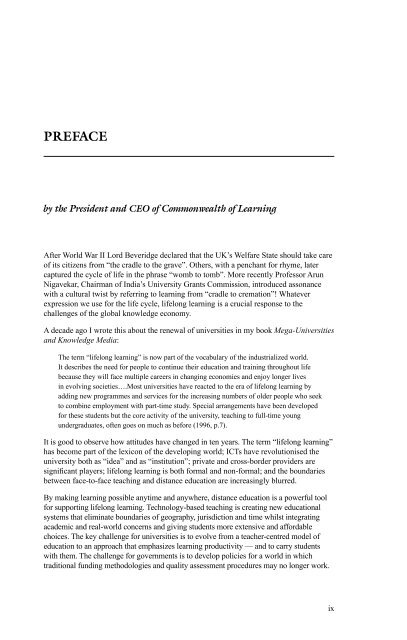lifelong learning and distance higher education - Asia Pacific Region
lifelong learning and distance higher education - Asia Pacific Region
lifelong learning and distance higher education - Asia Pacific Region
- No tags were found...
Create successful ePaper yourself
Turn your PDF publications into a flip-book with our unique Google optimized e-Paper software.
PREFACEby the President <strong>and</strong> CEO of Commonwealth of LearningAfter World War II Lord Beveridge declared that the UK’s Welfare State should take careof its citizens from “the cradle to the grave”. Others, with a penchant for rhyme, latercaptured the cycle of life in the phrase “womb to tomb”. More recently Professor ArunNigavekar, Chairman of India’s University Grants Commission, introduced assonancewith a cultural twist by referring to <strong>learning</strong> from “cradle to cremation”! Whateverexpression we use for the life cycle, <strong>lifelong</strong> <strong>learning</strong> is a crucial response to thechallenges of the global knowledge economy.A decade ago I wrote this about the renewal of universities in my book Mega-Universities<strong>and</strong> Knowledge Media:The term “<strong>lifelong</strong> <strong>learning</strong>” is now part of the vocabulary of the industrialized world.It describes the need for people to continue their <strong>education</strong> <strong>and</strong> training throughout lifebecause they will face multiple careers in changing economies <strong>and</strong> enjoy longer livesin evolving societies….Most universities have reacted to the era of <strong>lifelong</strong> <strong>learning</strong> byadding new programmes <strong>and</strong> services for the increasing numbers of older people who seekto combine employment with part-time study. Special arrangements have been developedfor these students but the core activity of the university, teaching to full-time youngundergraduates, often goes on much as before (1996, p.7).It is good to observe how attitudes have changed in ten years. The term “<strong>lifelong</strong> <strong>learning</strong>”has become part of the lexicon of the developing world; ICTs have revolutionised theuniversity both as “idea” <strong>and</strong> as “institution”; private <strong>and</strong> cross-border providers aresignificant players; <strong>lifelong</strong> <strong>learning</strong> is both formal <strong>and</strong> non-formal; <strong>and</strong> the boundariesbetween face-to-face teaching <strong>and</strong> <strong>distance</strong> <strong>education</strong> are increasingly blurred.By making <strong>learning</strong> possible anytime <strong>and</strong> anywhere, <strong>distance</strong> <strong>education</strong> is a powerful toolfor supporting <strong>lifelong</strong> <strong>learning</strong>. Technology-based teaching is creating new <strong>education</strong>alsystems that eliminate boundaries of geography, jurisdiction <strong>and</strong> time whilst integratingacademic <strong>and</strong> real-world concerns <strong>and</strong> giving students more extensive <strong>and</strong> affordablechoices. The key challenge for universities is to evolve from a teacher-centred model of<strong>education</strong> to an approach that emphasizes <strong>learning</strong> productivity — <strong>and</strong> to carry studentswith them. The challenge for governments is to develop policies for a world in whichtraditional funding methodologies <strong>and</strong> quality assessment procedures may no longer work.ix
















